Vibrant Pelvicachromis taeniatus “Nange” – Dwarf Cichlid, Easy Care African Fish for Thriving Aquatic Environments, Great for Dwarf Cichlid Tank Setups
£18.99 Original price was: £18.99.£16.00Current price is: £16.00.
Welcome these beautiful Vibrant Pelvicachromis taeniatus ‘Nange’ dwarf cichlids into your freshwater aquarium. Their stunning colors and elegant movements make them perfect for community tanks. Ideal for aquarists seeking peaceful companions and vibrant aquarium decorations.
Species Introduction
The Vibrant Pelvicachromis taeniatus “Nange”, commonly referred to as the African Dwarf Cichlid, is a captivating freshwater aquarium fish that originates from the lush waters of West Africa. These beautiful creatures are renowned for their vibrant colors and unique behaviors, making them a favorite among aquarists. In their natural habitat, they thrive in slow-moving rivers and streams where dense vegetation provides shelter and breeding grounds. The “Nange” variety is particularly appreciated for its striking coloration, which can range from deep blues to vibrant yellows, especially during mating displays. Understanding their natural environment is crucial for recreating a suitable habitat in your aquarium, ensuring these fish friends can flourish and exhibit their natural behaviors.
Care Requirements Dashboard
Essential Care Guide for Your Vibrant Pelvicachromis taeniatus “Nange”
| Optimal Living Conditions | |
|---|---|
| Water Temperature | 24-27°C (75-81°F) |
| pH Level | 6.5-7.5 |
| Water Hardness | 4-12 dKH |
| Minimum Tank Size | 80L (20 gal) |
| Salinity | Freshwater |
| Care Level | Beginner Friendly |
✓ Care Level: Easy
Natural Behavior & Temperament
The Vibrant Pelvicachromis taeniatus “Nange” exhibits a range of fascinating behaviors that make them a joy to observe. These dwarf cichlids are generally peaceful but can display territorial tendencies, especially during breeding. They thrive in a community tank setting, provided that tank mates are chosen wisely. Their social structure is complex; they often establish hierarchies within their groups. These fish friends are known for their playful swimming patterns, often darting through plants and decorations, which mimic their natural habitat. It’s essential to provide ample hiding spots and territories to reduce stress and aggression among tank mates. Observing their interactions can provide insights into their social dynamics, enhancing your aquarium experience.
Tank Setup Guide
Creating an ideal environment for your Vibrant Pelvicachromis taeniatus “Nange” involves careful consideration of tank setup. A minimum tank size of 20 gallons is recommended to provide ample swimming space and territories. The substrate should be soft and sandy, as this mimics their natural habitat and allows them to dig and forage. Incorporating live plants, such as Java Fern and Anubias, not only enhances the aesthetic appeal but also provides hiding spots and shelter. Rocks and driftwood can also be used to create caves and territories. Ensure that the tank is well-planted, as these fish thrive in environments where they can feel secure. Additionally, maintaining a gentle water flow will help replicate their natural riverine habitat.
Water Quality Management
Maintaining optimal water quality is crucial for the health and well-being of your Vibrant Pelvicachromis taeniatus “Nange”. Regular testing of water parameters is essential. The ideal pH level should range between 6.0 and 7.5, with a temperature maintained between 75°F and 82°F (24°C – 28°C). The hardness of the water should be kept between 5 to 15 dGH. Regular water changes of 20-30% every two weeks will help maintain water quality and remove toxins. Utilizing a quality filtration system will aid in keeping the water clean and clear. It’s also advisable to monitor ammonia, nitrite, and nitrate levels, as these can significantly impact the health of your fish friends. A well-maintained aquarium will not only support the health of your cichlids but also enhance their vibrant colors.
Feeding & Nutrition
Feeding your Vibrant Pelvicachromis taeniatus “Nange” requires a balanced diet that mimics their natural feeding habits. These dwarf cichlids are omnivorous and thrive on a varied diet. High-quality cichlid pellets, live or frozen foods such as brine shrimp and daphnia, and blanched vegetables like zucchini or spinach are excellent choices. A feeding schedule of 2-3 times per day is recommended, ensuring that only the amount they can consume in a few minutes is provided to prevent overfeeding. It’s essential to monitor their eating habits and adjust the diet accordingly, as some individuals may prefer certain foods over others. A well-rounded diet will promote vibrant colors and healthy growth.
Compatibility Guide
When considering tank mates for your Vibrant Pelvicachromis taeniatus “Nange”, it is vital to choose species that are compatible with their peaceful yet sometimes territorial nature. Ideal tank mates include other peaceful freshwater fish such as tetras, rasboras, and certain species of catfish. However, it is crucial to avoid aggressive species that may stress or harm your cichlids. A compatibility chart can be beneficial in determining suitable companions. Additionally, providing ample hiding spots and territories can help reduce potential conflicts. Observing interactions among tank mates will allow you to make adjustments as needed, ensuring a harmonious community tank environment.
Tank Mate Compatibility Guide
Great Tank Mates
- Peaceful tetras
- Rasboras
- Small catfish species
Avoid These Tank Mates
- Aggressive cichlid species
- Large predatory fish
Compatibility Note: Always research specific species requirements and observe fish behavior when introducing new tank mates. Individual fish personalities can vary!
Health & Wellness
The health and wellness of your Vibrant Pelvicachromis taeniatus “Nange” depend on several factors, including water quality, diet, and social environment. Common health issues include ich, fin rot, and stress-related conditions. Regular monitoring of your fish friends for signs of illness, such as changes in behavior, appetite, or physical appearance, is essential. Preventative measures include maintaining optimal water conditions, providing a balanced diet, and avoiding overcrowding. In case of illness, prompt treatment is crucial. Quarantining affected individuals can help prevent the spread of disease. Ensuring a stress-free environment with plenty of hiding spots can significantly enhance their overall well-being.
Breeding Information
Breeding Vibrant Pelvicachromis taeniatus “Nange” can be a rewarding experience for aquarists. These dwarf cichlids are known to be excellent parents. To encourage breeding, it is essential to create a breeding environment with suitable hiding spots and flat surfaces for egg-laying. The female typically lays eggs on a flat surface, and both parents will guard the fry once they hatch. The fry are usually free-swimming within a few days and can be fed infusoria or finely crushed flakes. It is crucial to ensure that the breeding pair is well-fed and healthy prior to spawning. Observing the breeding process can provide insights into their natural behaviors and enhance your understanding of cichlid care.
Acclimation Process
Acclimating your Vibrant Pelvicachromis taeniatus “Nange” to their new home is a critical step in ensuring their health and comfort. Upon introduction to the aquarium, it is essential to gradually acclimate them to the water conditions. This can be done through a drip acclimation method, where water from the tank is slowly introduced to the bag containing the fish over a period of several hours. This gradual process helps reduce stress and allows the fish to adjust to the new water parameters. Once acclimated, gently release them into the tank, avoiding any sudden movements that could frighten them. Monitoring their behavior in the initial days will help you ensure they are settling in well.
Long-term Care
Long-term care of your Vibrant Pelvicachromis taeniatus “Nange” involves understanding their lifecycle and growth expectations. These dwarf cichlids typically reach maturity at around 6 months of age and can live for up to 5 years or more with proper care. Regular monitoring of their growth and health is essential. As they mature, their colors may become more vibrant, especially during breeding displays. Maintaining a stable environment, providing a balanced diet, and ensuring good water quality will significantly contribute to their longevity. Observing their behaviors and interactions will also deepen your appreciation for these beautiful aquatic companions.
Natural Habitat Recreation
Recreating the natural habitat of the Vibrant Pelvicachromis taeniatus “Nange” in your aquarium is essential for their well-being. This can be achieved by incorporating elements that mimic their native environment. Soft, sandy substrates, along with live plants and natural decorations like driftwood and rocks, will create a comfortable and stimulating environment. The use of floating plants can also provide shade and cover, which is crucial for their sense of security. Additionally, maintaining a gentle water flow will help replicate the conditions found in their natural habitat. By creating a biotope that reflects their native waters, you will enhance their natural behaviors and overall health.
Seasonal Care Adjustments
Adjusting care for your Vibrant Pelvicachromis taeniatus “Nange” according to seasonal changes is vital for their health. During warmer months, it is essential to monitor water temperature closely, ensuring it remains within the optimal range of 75°F to 82°F (24°C – 28°C). In colder months, consider using a heater to maintain stable temperatures. Additionally, lighting adjustments may be necessary to simulate natural day/night cycles, which can influence their breeding behaviors and overall activity levels. Regular monitoring of water parameters throughout the year will help you make necessary adjustments to ensure a stable environment for your fish friends.
Expert Tips
For those looking to provide the best care for their Vibrant Pelvicachromis taeniatus “Nange”, here are some expert tips. First, consider keeping a small group of these cichlids to observe their social dynamics and behaviors. Additionally, ensure that your tank is well-planted with plenty of hiding spots to reduce stress and encourage natural behaviors. Regular water testing and maintenance are crucial in preventing health issues. Lastly, be patient and allow your fish friends to acclimate to their environment; stress can lead to health problems. By following these tips, you can create a thriving aquatic environment for your dwarf cichlids.
Troubleshooting
In the event of common issues arising with your Vibrant Pelvicachromis taeniatus “Nange”, it is essential to have a troubleshooting plan. If you notice signs of stress or illness, such as changes in color, lethargy, or loss of appetite, first check the water parameters to ensure they are within the ideal range. If aggression occurs among tank mates, consider adding more hiding spots or rearranging the tank to disrupt established territories. In case of disease, quarantine affected individuals and treat accordingly. Regular observation and a proactive approach will help you maintain a healthy and harmonious aquarium environment.
Scientific Background
The Vibrant Pelvicachromis taeniatus “Nange” belongs to the family Cichlidae, which is known for its diverse and colorful species. This family is characterized by their unique reproductive behaviors and complex social structures. Research indicates that cichlids exhibit remarkable adaptability to various environments, which contributes to their popularity in the aquarium trade. Conservation efforts are essential to protect their natural habitats, as many cichlid species face threats from habitat destruction and pollution. Understanding their scientific background can enhance your appreciation for these remarkable fish friends and the ecosystems they inhabit.
Advanced Care Techniques
For experienced aquarists looking to enhance their care for Vibrant Pelvicachromis taeniatus “Nange”, consider implementing advanced techniques. Breeding these cichlids can be a rewarding challenge; providing optimal conditions, such as specific water parameters and enhanced nutrition, can lead to successful spawning. Additionally, experimenting with aquascaping can create a visually stunning environment that promotes natural behaviors. Regularly participating in local aquarist groups or online forums can provide valuable insights and tips from fellow enthusiasts. By continuously learning and adapting your care techniques, you can ensure a thriving environment for your cichlids.
Frequently Asked Questions
Q: What tank size is required for Vibrant Pelvicachromis taeniatus “Nange”?
For Vibrant Pelvicachromis taeniatus “Nange”, a tank size of at least 60 litres (15 gallons) is recommended. This provides ample space for swimming and establishing territories, which is crucial for their well-being. Dwarf Cichlids are territorial, especially during breeding, so having enough space to create hiding spots with plants and decorations can help reduce aggression. A larger tank allows for more complex aquascaping, which can mimic their natural habitat and promote natural behaviours. Ensure the tank is well-filtered and stable to provide a healthy environment for your aquatic companions.
✓ Expert Tip
Consider providing a tank divider if introducing multiple males to prevent territorial disputes.
Q: What water parameters do Vibrant Pelvicachromis taeniatus “Nange” require?
Vibrant Pelvicachromis taeniatus “Nange” thrive in slightly acidic to neutral water with a pH range of 6.5 to 7.5. The water hardness should be between 5 to 15 dGH, and a temperature range of 24 to 28 degrees Celsius is ideal for their health and activity. Regular water testing is crucial to ensure these parameters remain stable, as fluctuations can lead to stress and health issues. Performing weekly water changes of 10-20% can help maintain water quality, alongside the use of a reliable filtration system.
✓ Expert Tip
Use a quality water conditioner to remove harmful chemicals during water changes.
Q: How often should I feed Vibrant Pelvicachromis taeniatus “Nange”?
Feeding Vibrant Pelvicachromis taeniatus “Nange” should occur 2-3 times a day with small portions that they can consume within a few minutes. A varied diet comprising high-quality pellets, frozen or live foods such as brine shrimp and daphnia will ensure they receive essential nutrients. Overfeeding can lead to poor water quality and health issues, so it’s vital to monitor their intake. Observing their behaviour during feeding can also help determine their health; if they are eager to eat, it is a good sign.
✓ Expert Tip
Rotating food types can enhance their colouration and health.
Q: What are the best tank mates for Vibrant Pelvicachromis taeniatus “Nange”?
Suitable tank mates for Vibrant Pelvicachromis taeniatus “Nange” include other peaceful community fish such as Tetras, Rasboras, and small Catfish. Avoid aggressive species that may provoke stress or territorial disputes. When introducing new tank mates, it’s best to do so gradually and monitor interactions closely. Providing adequate hiding spots and territories can help reduce potential conflicts. It’s advisable to keep them in a species-specific setup or with other dwarf cichlids to promote harmonious living.
✓ Expert Tip
Monitor the social dynamics within your tank to ensure all fish are thriving.
Q: How do I properly acclimatise Vibrant Pelvicachromis taeniatus “Nange” to my aquarium?
Acclimatising Vibrant Pelvicachromis taeniatus “Nange” involves a gradual process to reduce stress. Start by floating the sealed bag in the aquarium for about 15-20 minutes to equalise the temperature. Then, gradually introduce small amounts of your tank water into the bag over a period of an hour, allowing the fish to adapt to the new water conditions. After this, gently transfer the fish into the tank using a net, avoiding adding bag water to the tank. This method helps ensure a smooth transition and minimises shock.
✓ Expert Tip
Always acclimatise fish slowly; rushing can lead to health issues.
Q: What are the signs of healthy Vibrant Pelvicachromis taeniatus “Nange”?
Healthy Vibrant Pelvicachromis taeniatus “Nange” exhibit vibrant colours, clear eyes, and active behaviour. They should swim freely without signs of distress, such as clamped fins or lethargy. Regular feeding and engagement with their environment are also indicators of good health. Additionally, observe their social interactions; healthy fish typically display natural behaviours and socialise well with tank mates. Any sudden changes in appetite or behaviour may indicate stress or illness, requiring immediate attention.
✓ Expert Tip
Keep a close eye on water quality, as it directly affects fish health.
Q: How do I successfully breed Vibrant Pelvicachromis taeniatus “Nange”?
Breeding Vibrant Pelvicachromis taeniatus “Nange” requires a well-maintained environment with suitable conditions. Provide a breeding cave or flat surface for egg laying, and ensure the water temperature is slightly elevated (around 28 degrees Celsius). A separate breeding tank can reduce stress and territorial disputes. Once the female lays eggs, she will guard them fiercely while the male helps protect the territory. After hatching, the fry will need infusoria or finely crushed flakes for initial feeding. Regular monitoring will help ensure both fry and parents are thriving.
✓ Expert Tip
Consider separating the fry once they are large enough to avoid competition.
Q: What temperature should I maintain for Vibrant Pelvicachromis taeniatus “Nange”?
The ideal temperature range for Vibrant Pelvicachromis taeniatus “Nange” is between 24 to 28 degrees Celsius. Maintaining a stable temperature within this range is crucial as fluctuations can lead to stress and health issues. A reliable aquarium heater with a thermometer is recommended to ensure consistent warmth. Regular monitoring of the water temperature will help you maintain optimal conditions for your fish friends, promoting their overall health and activity levels.
✓ Expert Tip
Position the heater away from water flow to ensure even temperature distribution.
Q: How long do Vibrant Pelvicachromis taeniatus “Nange” typically live in captivity?
In captivity, Vibrant Pelvicachromis taeniatus “Nange” typically have a lifespan of 5 to 10 years, provided they are given proper care and optimal living conditions. Factors influencing their longevity include water quality, diet, and social environment. Regular monitoring and maintenance of the aquarium will significantly contribute to their well-being and life span. Keeping them in a stable and appropriate environment allows them to thrive and enjoy a long, healthy life.
✓ Expert Tip
Regular health checks will help you spot any potential issues early on.
Q: What type of substrate is most suitable for Vibrant Pelvicachromis taeniatus “Nange”?
A fine, sandy substrate is most suitable for Vibrant Pelvicachromis taeniatus “Nange”, as it mimics their natural habitat and allows for digging behaviours. Sandy substrates are gentle on their delicate fins and encourage natural foraging behaviours. You may also consider adding some smooth rocks and driftwood to create hiding spots and territories, which is essential for their comfort and security. Regular cleaning of the substrate will help maintain water quality and prevent the buildup of harmful waste.
✓ Expert Tip
Avoid sharp substrates that could injure your fish friends.
Q: What behavioural patterns should I expect from Vibrant Pelvicachromis taeniatus “Nange”?
Vibrant Pelvicachromis taeniatus “Nange” exhibit a range of fascinating behaviours. They are known for their territorial nature, especially during breeding, where males display vibrant colours and engage in courtship rituals. These fish enjoy exploring their environment, often foraging along the substrate. They may also establish a hierarchy within their group, leading to occasional displays of dominance. Observing their interactions can be quite rewarding, as they often engage in playful chases and social behaviours when comfortable in their environment.
✓ Expert Tip
Create a varied environment to encourage natural behaviours and reduce stress.
Q: How can I prevent common diseases in Vibrant Pelvicachromis taeniatus “Nange”?
Preventing common diseases in Vibrant Pelvicachromis taeniatus “Nange” starts with maintaining optimal water quality, as poor conditions can lead to stress and illness. Regular water changes, proper filtration, and avoiding overfeeding are essential. Quarantining new fish for at least two weeks before introducing them to the main tank can help prevent the spread of diseases. Additionally, providing a balanced diet rich in vitamins and minerals supports their immune system. Keeping an eye on their behaviour and appearance can help you catch any signs of illness early.
✓ Expert Tip
Regularly inspect your fish for any signs of distress or illness.
Q: What lighting conditions do Vibrant Pelvicachromis taeniatus “Nange” prefer?
Vibrant Pelvicachromis taeniatus “Nange” thrive under moderate lighting conditions, as they are naturally found in shaded areas of their habitat. A combination of ambient and focused lighting can help enhance their colours without causing stress. Using live plants can also help diffuse the light, creating a more natural environment. It is advisable to provide a light cycle of around 10-12 hours a day, ensuring a consistent routine that mimics their natural day-night cycle, promoting healthy behaviour and activity.
✓ Expert Tip
Consider using a dimmer switch to adjust the lighting intensity as needed.
Q: How do I recognise stress in Vibrant Pelvicachromis taeniatus “Nange”?
Recognising stress in Vibrant Pelvicachromis taeniatus “Nange” is crucial for their well-being. Signs of stress may include hiding excessively, clamped fins, loss of colour vibrancy, and erratic swimming patterns. Additionally, they may exhibit reduced appetite or aggression towards tank mates. Changes in their usual behaviour can indicate discomfort or stress due to poor water quality, unsuitable tank mates, or environmental changes. It is important to address these issues promptly to ensure their health and happiness.
✓ Expert Tip
Maintain a stable environment to minimise stress and promote healthy behaviour.
Q: What natural habitat conditions should I replicate for Vibrant Pelvicachromis taeniatus “Nange”?
To replicate the natural habitat of Vibrant Pelvicachromis taeniatus “Nange”, aim for a soft, sandy substrate with plenty of hiding spots created by rocks and driftwood. They thrive in slightly acidic to neutral waters with lush vegetation, mimicking their natural environment. Incorporating live plants can provide shelter and foraging opportunities, enhancing their comfort. Maintaining stable water conditions with a gentle current will also help create a suitable habitat, allowing these stunning fish to exhibit their natural behaviours.
✓ Expert Tip
Research their natural habitat to better understand their needs and behaviours.

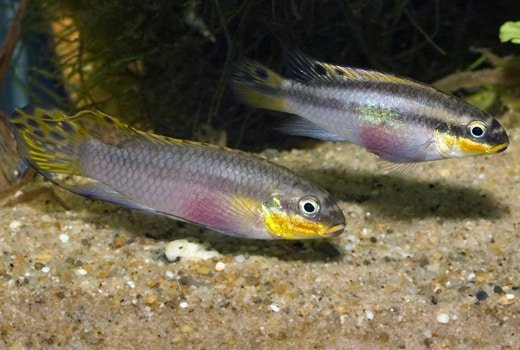
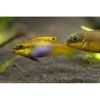



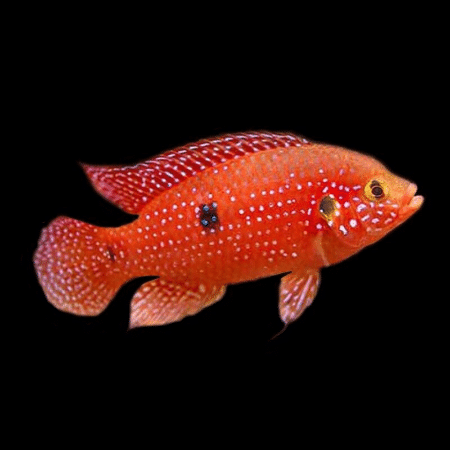
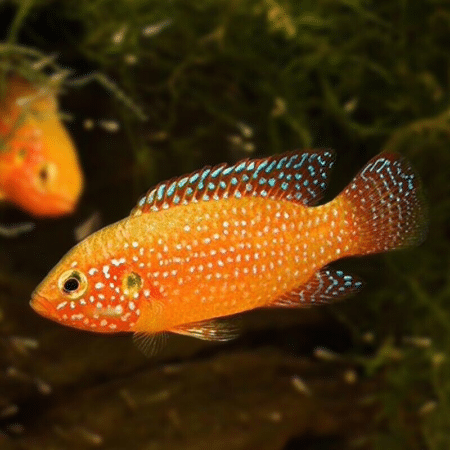

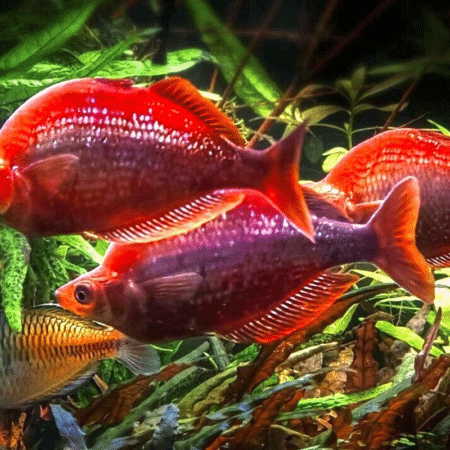





Emily Carter (verified owner) –
As an experienced hobbyist, I can confidently say that the Vibrant Pelvicachromis taeniatus “Nange” is an absolute gem among African cichlids! I introduced them to my 30-gallon tank about a month ago, and they’ve brought so much life and color. Their mesmerizing patterns and vibrant colors are even more stunning in person than in the photos!
I’ve noticed they’re quite social, often interacting with each other and exploring their environment. I set up a few caves and hiding spots, which they utilize, creating a natural habitat for them. I’ve found that they thrive best with a slightly acidic pH, which is something I appreciate about these dwarf cichlids— they adapt well!
Compared to other cichlids I’ve kept, the Nange variety is calmer and more peaceful, making them ideal for community tanks. My only minor concern is that they can be a little shy until they settle in, but once they do, their personalities shine!
I wholeheartedly recommend these cichlids to anyone looking to add a splash of color and character to their aquarium—especially for those who are new to keeping African cichlids. You won’t regret it!
Emily Carter (verified owner) –
I’ve been keeping fish for over five years, and I can confidently say that the Vibrant Pelvicachromis taeniatus ‘Nange’ is one of my favorite additions to my aquarium! After getting them about two months ago, their colors have just exploded, making my African cichlid tank feel so lively and vibrant. These dwarf cichlids are not only stunning to look at, but they also have such unique personalities. Each one has its own quirks, which truly brings my aquarium setup to life.
They settled in quickly—much faster than some of the other cichlids I’ve tried in the past. I’ve kept them in a 20-gallon tank with plenty of hiding spots, and they seem to thrive in that environment. I do recommend providing them with some sandy substrate and live plants to mimic their natural habitat. Just a small note: I did notice they can be a bit territorial during breeding, so ensure you have enough space!
Overall, I highly recommend these fish for anyone who loves dwarf cichlids or is starting out in the aquarium hobby. They are easy to care for, and their lively behavior is so rewarding. I plan to get a few more soon to expand my little community!